Renewing our Seattle Transportation Benefit District (STBD)

Note: After voters approved in November 2020 the renewal of our “Seattle Transportation Benefit District” (STBD via Ordinance 126115 sponsored by Transportation Chair Alex Pedersen), the Seattle Department of Transportation (SDOT) “re-branded” it as the “Seattle Transit Measure” (STM). For a link to SDOT’s updated website on the voter-approved measure, CLICK HERE.
NOVEMBER 2022: Transit Service Hours Preserved; Reserves Tapped for More Capital Projects
While King County Metro bus ridership in 2022 was about half of what it was in 2019 (before the pandemic), City Council thankfully maintained the Transit Service Hours portion of the Seattle Transportation Benefit District (STBD) as part of the Council’s November 2022 budget decisions. With late-breaking budget deficits in other areas impacting SDOT’s overall budget and calls for more investments in transportation capital projects, the Council approved an amendment to shift un-designated reserves to STBD’s “infrastructure maintenance and capital improvements” category. This was on top of a smaller increase in that capital category already proposed by the Harrell Administration. In addition, a budget proviso for just 2023 directs SDOT to invest $12 million (of the now $15 million in boosted capital funding) to keep open and safe some of Seattle’s aging, long-neglected multimodal bridges on which buses rely. Recently, several Seattle bridges that carry buses have been closed or stuck (such as the West Seattle “high” Bridge, Spokane Street Bridge, Ballard Bridge, Fremont Bridge, and University Bridge) and a 2020 audit of bridges confirmed several bridges are rated poorly, yet could be improved in a cost-effective manner by upgrading their moveable components. The City’s budget action did not re-allocate dollars away from STBD’s Transit Service Hours, the primary source of funds for the temporary boost to capital projects was un-designated reserves, the City followed the State-authorized material change process for benefit districts, all funding still has a connection with transit as called for by the STBD program, and there is no bonding involved.
AUGUST 16, 2022: Annual Report of “Seattle Transit Measure” (also known as STBD).
SDOT presented their annual report of the Seattle Transit Measure. For the full 24-page report, CLICK HERE. For the briefer presentation made to our Transportation Committee on August 16, 2022, CLICK HERE. For SDOT’s blog post on it, CLICK HERE. Calling it a “Year 1 Report” is a bit of a misnomer because it covers 18 months. According to the report, “This report details programmatic activities and financial information for both the final six months of the 2014 Seattle Transportation Benefit District Proposition 1 (which expired at the end of 2020) and the first year of the 2020 Seattle Transportation Benefit District Proposition 1 (approved by voters in November 2020 to replace the expiring measure).
Next Steps: A key takeaway for me is how transit ridership and the categories of funding are in flux for several reasons. (1) Due to commuters working more days at home, bus ridership remains much lower than in 2019 (“Transit Service”); (2) due to a change in State law, King County will now provide free transit for riders 18 years of age and younger (“Transit Access Program”); and (3) due to the re-opening of the West Seattle Bridge on September 18, 2022, less spending is required for re-routing and supplementing work-arounds (“Emerging Needs”). The changes for just the free transit and re-opening of the bridge, can free up nearly $8 million out of the $52 million spending package for 2023. I believe these funds should be considered within the context of how to invest SDOT’s $700 million budget, the increasing need to care for Seattle’s aging transportation infrastructure that supports transit, and the need to fulfill promises made when voters approved the massive property tax measure in 2015 called “Move Seattle” that may need to be renewed in 2024.
NOVEMBER 3, 2020 at 8:15 p.m. (after polls closed) UPDATE:
“Winning this election is more than just a victory for the transit that Seattle loves — choosing to fund robust bus service is a bold affirmation that we are upbeat about a future when everyone gets back to work, our economy gets moving again, and we make real progress on the climate crisis,” said Seattle Councilmember Alex Pedersen who, despite the pandemic, led passage of the transit measure through the Seattle City Council as Chair of the Transportation Committee for voters to decide.
- For the Seattle Times article about the victory for STBD, CLICK HERE.
- For the Mayor’s press release about the victory for STBD, CLICK HERE.
- For the Seattle Times editorial board endorsement (posted here for reference only after the measure was approved by voters), CLICK HERE.
JULY 27, 2020 UPDATE:
After a lengthy debate on several amendments — your City Council unanimously approved a 6-year transit measure with a 0.15% sales tax to send to the November ballot, giving voters the option to renew funding for our Transportation Benefit District. The current measure is funded by a 0.1% sales tax (the 0.1% of the 10.1% total sales tax in Seattle). To keep promises I previously made about not increasing the sales tax, I voted against the amendments to increase the Mayor’s across-the-board renewal. But, in the spirit of compromise and unity that City Hall so desperately needs during these tumultuous times, I ultimately joined all of my colleagues to make sure we put this important transit measure on the ballot for voters to decide.
As chair of the Committee that initiated this transit legislation to get it done on time, I believe it was healthy for our city government to have a robust, yet respectful debate on the tradeoffs of the various details and then to compromise to move it forward for voters to decide.
My comments at the conclusion of the City Council debate:
“This is a good day for public transit. Many were concerned that, with the turmoil and uncertainty of the COVID pandemic and economic recession, we might not be able to renew the funding for the Transportation Benefit District. In fact, our colleagues at King County had to abandon a regional measure, as they shifted their attention to the public health crisis. It was up to us, here in Seattle, to beat the clock before the money for transit expired. Fortunately, we share common ground that public transit is an essential and affordable option to move the most people in our region, as we look forward to a vibrant economy and a healthy planet.
And, despite the divisions and conflicts that many people see reported in the media, the Mayor and the City Council can pull together and row in the same positive direction — when we direct our energy toward the hard responsibility of governing.
My statement as Council adopted the measure for voter consideration:
“Because public transit is an essential and affordable option to move the most people in the most environmentally friendly way as our economy recovers, I’m thankful the Mayor and a unanimous City Council agreed to provide Seattle voters with the option this November to renew funding for the successful Seattle Transportation Benefit District during these challenging and uncertain times.”
For more information:
- For the measure approved by City Council (Council Bill 119833 which became Ordinance 126115 which will become Seattle Proposition 1), CLICK HERE.
- For the approved companion Resolution 31960, CLICK HERE.
- Mayor Durkan’s joint statement with Council President Gonzalez, CLICK HERE.
- Website for the Seattle Transportation Benefit District: https://www.seattle.gov/transit/about-stbd/2021-proposal-to-provide-reliable-transit
- For the Seattle Times article on Council’s action, CLICK HERE.
JULY 17 and 27, 2020 UPDATE: I chaired the City Council’s Committee on Seattle Transportation Benefit District Funding on July 17, 2020 and we unanimously advanced Council Bill 119833 to renew funding for that important transit measure. Prior to passage, we voted on all 7 of the published amendments.
A theme of the amendments was to emphasize transit service over roadwork. This included my Amendments #1 to allocate more money to transit service and #4 to ensure that the measure uses at least a majority of its funding for transit. Both amendments passed unanimously.
Another key amendment shortened the length of the renewal from six years to four years, which I opposed because I believe the six years provides a more reliable, longer-term funding source and gives Seattle leverage when negotiating with King County for a future regional measure. [UPDATE: On July 27, 2020 the full City Council restored the length to six years.] There was a lengthy and cordial debate on the pros and cons of six years vs. four years, which I believe shows how our City Council can work together on tough decisions with mutual respect. A final amendment that would have doubled the amount of the sales tax (from 0.1% to 0.2%) was walked on by Councilmember Tammy Morales, discussed at length, and ultimately withdrawn due to lack of immediate support. [UPDATE: On July 27, 2020, the full Council agreed on a sales tax level in the middle: 0.15%]
For details on the amendments and votes at the July 17, 2020 committee, review this article by SCC Insight by CLICKING HERE. For details on the July 20, 2020 full City Council discussions, CLICK HERE.
Our full City Council will vote on this important transit measure NEXT Monday, July 27. The deadline is Aug 4 to put it onto the November ballot for voters to consider.
JULY 7, 2020 (Original Post):
I am hopeful you and your neighbors will get to decide whether to renew the Seattle Transportation Benefit District (STBD) at the November 2020 election. I’m honored to chair the City Council Committee on STBD that will be considering it this month.
WHAT IS STBD?
STBD is the Seattle Transportation Benefit District. It’s another way that State law allows cities to raise money for transportation needs.
CURRENT: From the 6-year measure approved by Seattle voters in 2014, we raised about $55 million in 2019 with a combination of a 0.1% sales tax and $80 car tabs, also known as vehicle license fees ($60 approved by voters plus $20 approved just by the City Council).
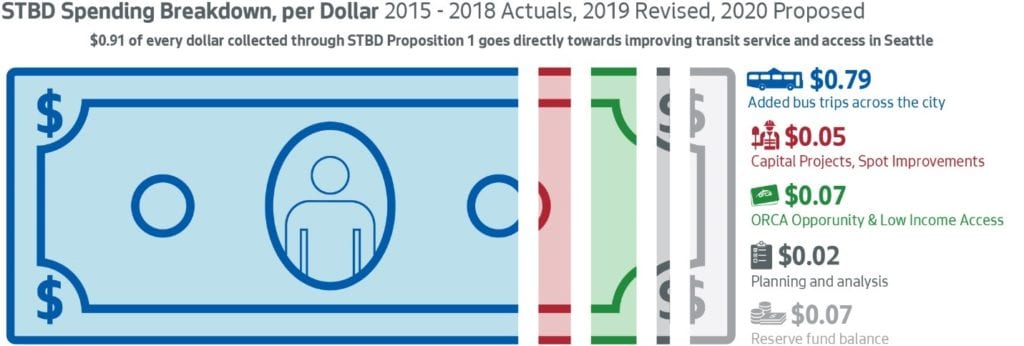
PROPOSAL TO RENEW: Many elected officials and I believe we should provide voters with the opportunity to renew the measure for another six years by continuing the 0.1% sales tax we are already paying. Mayor Durkan agrees and she sent such a proposal to City Council July 7. State law allows us to ask voters to double it (to 0.2%), but we do not think such an increase makes sense considering current economic challenges. Depending on the sales of goods and services in the coming years, the 0.1% should raise approximately $25 million per year (about half the amount of the current measure because it excludes car tab revenue).
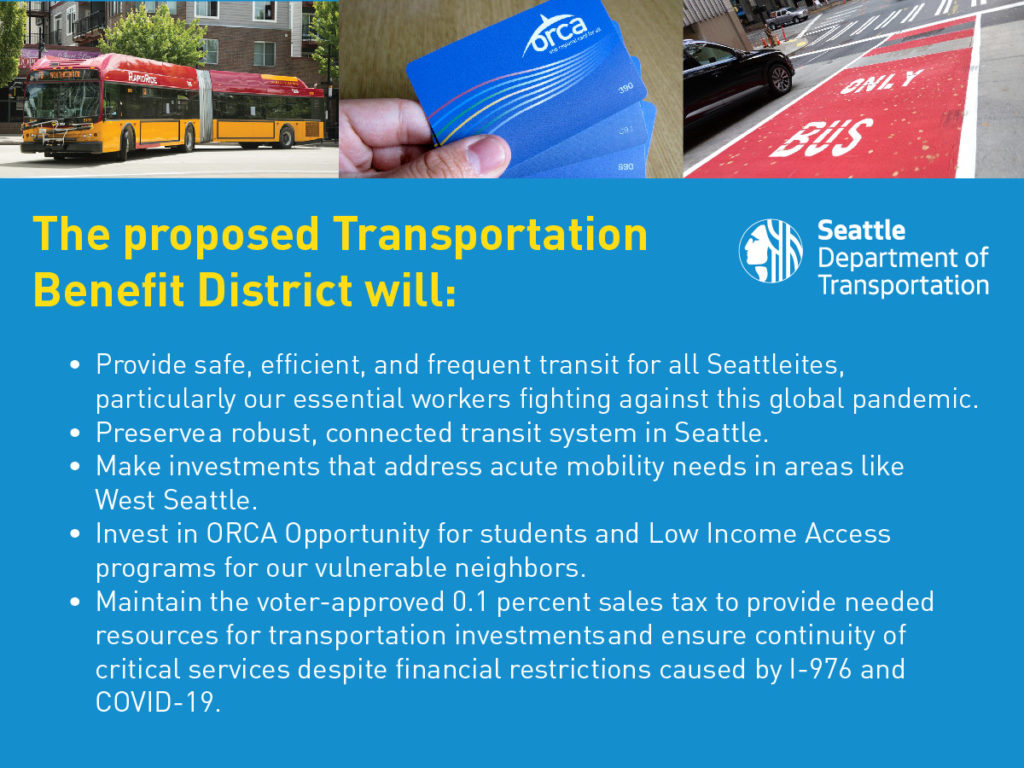
[Note: Tim Eyman’s statewide Initiative 976 approved by voters in November 2019 (even though 76% of Seattle voters rejected it) suspends our ability to collect the car tab dollars, though some localities (including the City of Seattle) are suing to overturn I-976. If the courts overturn I-976, the City Council would have the authority under State law to continue to collect $20 of the car tabs and increase that to $40.]
For at least three reasons, I hope my colleagues on the City Council will join me in putting onto the November ballot the opportunity to renew Transportation Benefit District funding:
1. STBD Delivered: The STBD approved by voters in 2014 was very successful and has earned the right for renewal consideration.
2. Transit is Vital: Mass public transit moves the most people in the most affordable and environmentally friendly way.
- Essential: While transit ridership is down due to COVID, transit remains a transportation lifeline for thousands of our neighbors — it’s essential transportation for essential workers. Moreover, transit will undergird our economy as it reopens and revitalizes. In the first year of renewal, we face a tremendous need to increase transportation options for the 100,000 residents of West Seattle until the high bridge is replaced.
- Affordable: Because society smartly subsidizes this public good, bus transit is affordable and helps low and moderate income neighbors get to their jobs, schools, and errands.
- Environmental: Increasing transit ridership is a key solution to address climate change and traffic congestion.
3. This Renewal is Reasonable: The renewal simply asks people to pay what they already pay. It is not a stealth increase hidden under the term “renewal” as with some ballot measures.
(For a more detailed Pros and Cons section, see below.)
Here’s my recent quote on renewing STBD:
“I believe we must provide Seattle with the option to renew our successful Transportation Benefit District before it expires because it’s essential, affordable, and green,” said Councilmember Alex Pedersen, Chair of the City Council’s Transportation Committee. “Our economy, our workers, and our environment are counting on us to preserve our basic transit services. Continuing this small tax is important as our economy reopens to preserve transit subsidies for our low income neighbors, seniors, and students — and to make sure buses get people everywhere they need to go, which includes boosting access to and from West Seattle.”
SCHEDULE:
- July 1, 2020: Our City Council President creates a temporary “Select Committee on Seattle Transportation Benefit District Funding” chaired by me (because I chair the Council’s regular Transportation & Utilities Committee).
- July 7, 2020: Ballot measure language transmitted by Mayor Durkan/SDOT to City Council.
- Friday, July 10: STBD Funding Committee; presentation by SDOT.
- Monday, July 13: City Council approves its Introduction and Referral Calendar (to refer the STBD ballot measure to the STBD Funding Committee)
- Friday, July 17: STBD Funding Committee amends bill and votes.
- Monday, July 27: the “Full” (regular) City Council votes.
- Tuesday, Aug 4: deadline for our City Clerk to transmit the Council-adopted and Mayor-signed measure to King County Elections (for putting on the November 3 ballot for Seattle voters).
- Tuesday, Nov 3: final day to vote on the STBD measure. Votes of at least 50% + 1 in favor of renewed STBD funding would approve the measure.
AMENDMENTS:
One outstanding issue is how much STBD money should be invested in “infrastructure maintenance and capital improvements” that support the transit system. This bar graph from the Executive’s presentation to the July 10 meeting of the STBD Committee shows these expenditures in orange:
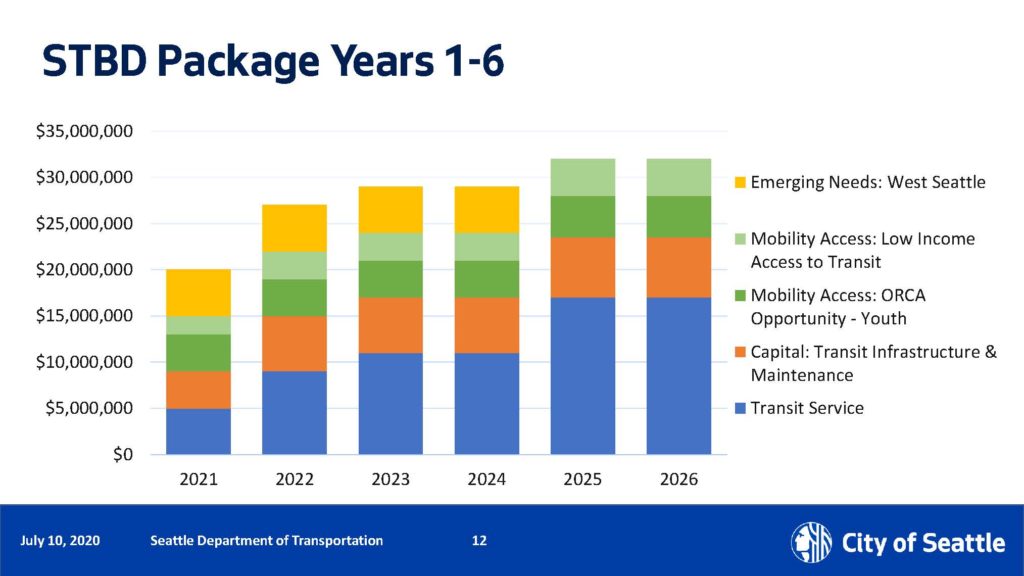
The bill, as introduced, actually allows for more ‘orange’ expenditures than shown on this graph—up to $9 million per year. The graph is based on SDOT’s planned 2021 budget proposal and future estimates. I am open to calls for further limiting the amount of STBD dollars invested in infrastructure, so that we increase the amount allocated to transit service.
QUOTES FROM KEY STAKEHOLDERS (July 7):
Urban League of Metropolitan Seattle, President & CEO Michelle Merriweather: “Transit justice cannot be separated from the right for racial and economic justice. In Seattle, the Black community and other communities of color are more likely to have to commute farther for work, and to live in areas with higher rates of poverty, pollution and other harmful environmental stressors. At the Urban League, we fight for access to lasting opportunity for African American and other underserved communities. Access to safe, reliable, and affordable transit is absolutely critical for our work, and this proposal is a step in the right direction.”
SDOT Transportation Equity Workgroup, Co-Chair Rizwan Rizwi: “I joined SDOT’s Transportation Equity Workgroup to ensure that people had a say in transportation decisions even though they may have very low incomes and be from populations which are not usually represented when policy is being designed. Doing what is right can be difficult especially in periods of economic uncertainty, while the STBD proposal is not perfect, it is the right decision for Seattle and I look forward to helping shape investment decisions alongside the City and its residents.”
Amalgamated Transit Union, Local 587 President Ken Price: “ATU 587 represents the transit workers, who have suffered greatly to keep essential service moving and get Seattleites where they needed to go during the COVID-19 pandemic. Even as communities were told to stay home and stay healthy, our bus drivers and other essential workers showed up on the front lines to keep people safe, moving, and healthy. May we forever honor our transit workers who lost their lives. We applaud the Mayor for thinking ahead to the future needs of Seattle and the ongoing mobility struggles. ATU 587 is proud to support this proposal which meets both the needs of our members and all of the working people in Seattle.”
Transportation Choices Coalition, Executive Director Alex Hudson: “Access to safe and reliable transit service is critical during the COVID-19 pandemic and beyond. Transit is essential and we must ensure that those who rely on transit can get where they need to go. If we choose to disinvest in transit now, the consequences will be devastating for generations to come. We can’t let I-976 and the pandemic stop our incredible progress over the last decade. We must keep transit running for the health and future of our city.”
Downtown Seattle Association, President & CEO Jon Scholes: “As we think about an economic recovery from COVID-19 for our downtown core, we must have reliable transit to ensure people can get where they need to go. Investing in our system’s infrastructure and service will be critically important requires a new commitment from all levels of government to ensure access to jobs.”
West Seattle Bridge Community Task Force, Co-Chair Paulina López: “A new STBD package can play a key role in our efforts to not only reconnect West Seattle, but mitigate the disproportionate impacts felt by many in the region. With the closure of the West Seattle High-Rise Bridge in March, detour routes off the peninsula lead traffic south. The increased traffic along the detour routes disproportionately impact the south end of West Seattle and Duwamish Valley where communities already face higher rates of asthma, air pollution, and congestion...”
MLK Labor, Executive Secretary Treasurer Nicole Grant. “MLK Labor has a long history of supporting transportation benefit district proposals because working class people rely on public transportation to get to work. Now more than ever, essential workers need safe and reliable access to transit so they can perform the jobs that society relies on us for.”
Rooted in Rights, Director Anna Zivarts: “People who are transit-dependent need to be able to access our communities. We will continue to fight for reliable, accessible, and equitable transit that gets us where we need to go.”
POTENTIAL PROS AND CONS:
Before I was elected last year, I would often criticize government officials for being “cheerleaders” for tax measures without presenting pros and cons. So, here are some points to contemplate as the City Council considers putting the STBD renewal onto the November ballot:
Pro: SUCCESSFUL: The 2014-2020 STBD delivered on its promises and has earned renewal.
- Con: After voters approved STBD in 2014, City leaders expanded it in 2018 into other program areas not originally envisioned by the voters.
- Rebuttal: The changes to the program did not take away from what voters approved, but rather expanded the scope to include free ORCA passes to public school students and other subsidies benefiting those in need.
Pro: CONTROL: A Seattle measure enables Seattle to emphasize the routes it wants when it wants them. This is very important considering the fact that we need to shift more bus service to West Seattle while the West Seattle “high bridge” is out of commission.
- Con: SHOULD BE REGIONAL: Transportation is a regional issue requiring regional solutions.
- Rebuttal: Yes AND the systems are regional (King County Metro for buses and Sound Transit for light rail and buses). STBD supplements service within the regional system because Seattleites use it so much. Moreover, Seattle collaborated for months with King County elected officials to consider a regional measure for the ballot. But early this year, the County suddenly needed to focus on the public health response to COVID, which led them to postpone the regional discussions for the foreseeable future. And, frankly, County voters, on average, have been less enthusiastic about supporting transit tax measures than Seattle voters. The current STBD is expiring which requires a decision this year. Those eager for more dollars to go toward transit should know that, in addition to Seattle having the ability to vote for more, King County also has the authority in the future to ask voters to pay up to 0.2% additional sales tax (and Seattle would typically get nearly half the benefit of such a measure). In other words, King County could ask voters throughout the county to approve a measure — in addition to Seattle’s — as the need for transit grows again.
Pro: “AFFORDABLE”: Mass transit for the public provides an affordable transportation option to move people to and from jobs, schools, and other important activities that keep our economy and daily lives moving.
- Con: It’s affordable if you use it. If you don’t use the transit, you still might be paying for it depending how it’s funded.
- Rebuttal:
- We all hate traffic. If more people ride transit, there will be fewer cars on the road — which will reduce traffic for those who need to use a car.
- To provide some context about cost, mass transit is generally considered a societal benefit (for reasons mentioned throughout this post) and, throughout the U.S., taxpayers subsidize this benefit: fares paid by riders typically cover less than half of the cost to operate a transit system (i.e. the “farebox recovery ratio” is less than 50%. For more info on this, CLICK HERE).
Pro: GOOD FOR THE EARTH. We need to address climate change and most low occupancy vehicles, like cars, are a major source of harmful emissions.
- Con: There’s not really a con here unless a bus is using gasoline (instead of an electric or hybrid) and is completely empty.
Pro: IT’S JUST A RENEWAL: Instead of imposing a new or higher tax on residents, this is just a renewal of the existing STBD tax.
- Con: RIDERSHIP IS DOWN: Due to the COVID pandemic with the need for social distancing and the increase in employees working remotely, bus ridership has plummeted — why not just let the tax expire?
- Rebuttal:
- Tens of thousands of essential workers are still using transit in the midst of this pandemic and transit will be an affordable transportation option for all workers — especially low-income workers — as the economy reopens and recovers.
- Moreover, we have tremendous financial needs to deal with our city’s bridge problem — including the need to increase options for 100,000 people in West Seattle until the bridge is repaired or replaced.
Pro: REDUCES TRAFFIC: We all hate traffic (as noted earlier). If more people ride transit, there will be fewer cars on the road which will reduce traffic for those who need to use a car.
- Con: TAX: It’s a tax.
- Rebuttal: Even though I’m a Seattle Democrat, I have not been afraid to question and even vote against an occasional tax measure. But, for the reasons noted above, I strongly support this one (STBD renewal). Moreover, the City Council is simply putting STBD onto the November ballot to give that choice to you.
Pro: NOT A TAX INCREASE. We already pay the 0.1% sales tax and would simply continue it under the renewal.
- Con: REGRESSIVE: A sales tax is regressive (and so are car tabs a.k.a. vehicle license fees) — and regressive taxes are bigger burden to lower income families than to higher income families because lower income families pay a greater portion of their income.
- Rebuttal: Until our State government provides more progressive options to raise revenue for transit, we have little choice but to use existing State law. Also, the proposal for renewing the STBD is simply to maintain the existing 0.1% sales tax, rather than increasing the tax. From the perspective of the taxpayer, if Tim Eyman’s initiative 976 survives our lawsuit, people will be paying less for STBD because they will no longer pay the $80 car tab ($60 from STBD approved by voters in 2014 and $20 approved by City Council). From the perspective of the city government and transit riders, this loss of revenue to support transit makes STBD’s 0.1% sales tax even more vital.
Pro: FLEXIBILITY: Buses are highly flexible because we can change routes as needed vs. a fixed system such as a streetcar or light rail. Of course Seattle loves its light rail and it’s already a vital spine of our regional transit system that is, thankfully, growing as our population increases. Many of us District 4 residents are looking forward to the new stations opening in the U District (Brooklyn Ave) and Roosevelt neighborhoods, thanks to the Sound Transit 2 measure. It’s important to note, our light rail system relies heavily on buses to move people ‘the first-last mile’ to and from the stations — another reason we should advance STBD renewal to the November ballot.
- Con: I could not think of a negative here. Buses are flexible and an essential piece of our regional transportation system. Granted, light rail is cooler, but you need to be able to get to a station. You can take a bus!
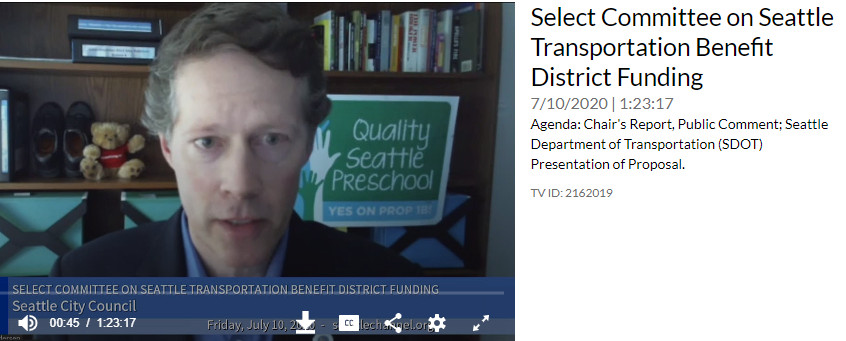
MORE INFO:
INFORMATIONAL WEBSITES:
- For STBD’s current website, CLICK HERE.
- For SDOT’s blog post on STBD: CLICK HERE.
- For our City Council’s Committee website, CLICK HERE.
- For a video of our STBD Funding Committee from July 10, 2020, CLICK HERE.
- For STBD’s original 2010 and 2014 legislation, CLICK HERE.
PROPOSAL:
- For the proposed ordinance as submitted by the Mayor to the City Council, CLICK HERE and as officially introduced as Council Bill 119833, CLICK HERE.
- For the presentation to the STBD Committee on July 10, 2020, CLICK HERE.
- For the memo from our City Council Central Staff for the July 10, 2020 STBD Committee, CLICK HERE.
- For Mayor Durkan’s press release transmitting her proposed STBD legislation to the City Council on July 7, 2020, CLICK HERE.
ORCA CARDS: To see whether you qualify for the ORCA Opportunity (free for students and public housing authority residents), CLICK HERE or ORCA Lift (50% off if you are in a low income household), CLICK HERE.
EQUITY: For the Transportation Equity Workgroup, CLICK HERE.
NEWS:
- Seattle Times article, July 10, 2020: https://www.seattletimes.com/seattle-news/transportation/new-tax-plan-would-spend-less-on-seattle-bus-service-more-on-low-income-and-west-seattle-programs/
- Seattle Times article, July 7, 2020: https://www.seattletimes.com/seattle-news/transportation/with-coronavirus-and-car-tab-hits-seattle-pitches-scaled-back-tax-for-bus-funding/
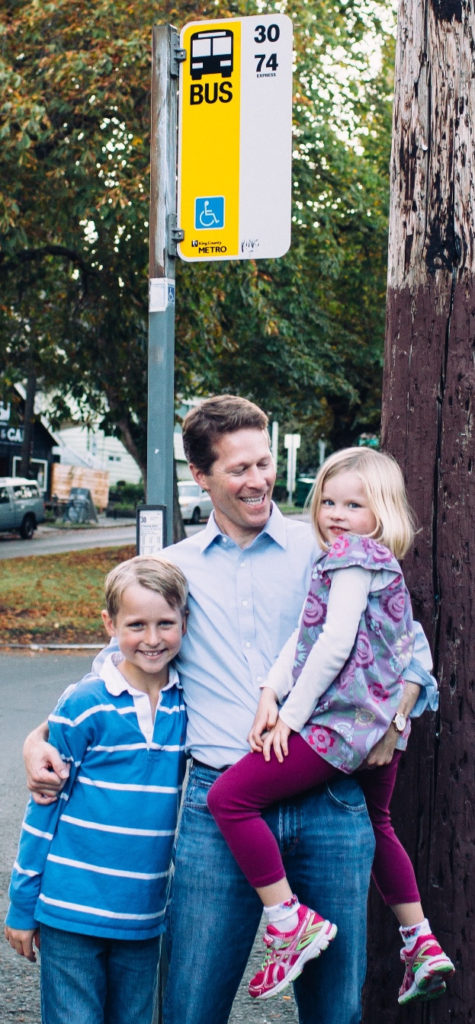
Posted: July 7th, 2020 under Councilmember Pedersen


Pingback from Council Connection » Pedersen’s Statement Following Council Approval of Seattle Transportation Benefit District (STBD) Funding Measure
Time July 28, 2020 at 8:29 am
[…] Councilmember Pedersen’s website blog: https://pedersen.seattle.gov/renewing-our-seattle-transportation-benefit-district-stbd/ […]